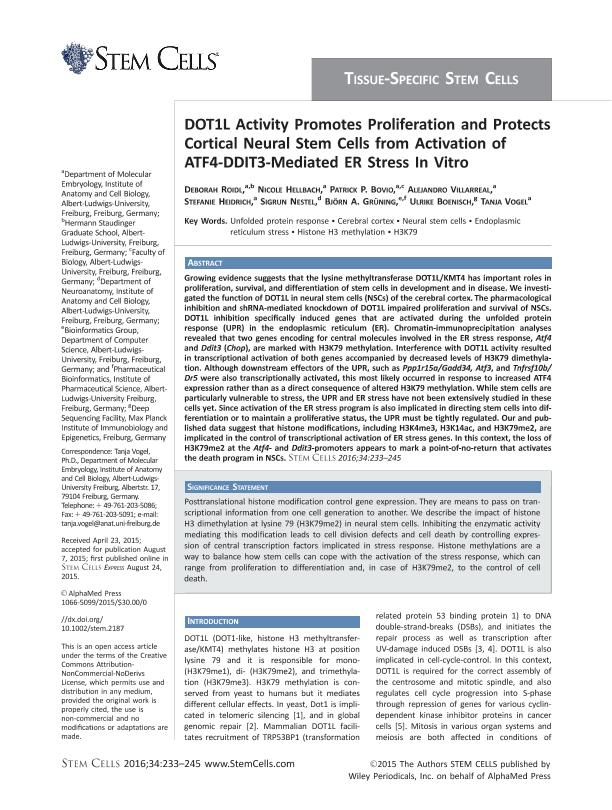Mostrar el registro sencillo del ítem
dc.contributor.author
Roidl, Deborah
dc.contributor.author
Hellbach, Nicole
dc.contributor.author
Bovio, Patrick P.
dc.contributor.author
Villarreal, Alejandro

dc.contributor.author
Heidrich, Stefanie
dc.contributor.author
Nestel, Sigrun
dc.contributor.author
Grüning, Björn A.
dc.contributor.author
Boenisch, Ulrike
dc.contributor.author
Vogel, Tanja
dc.date.available
2019-01-08T20:03:14Z
dc.date.issued
2016-01
dc.identifier.citation
Roidl, Deborah; Hellbach, Nicole; Bovio, Patrick P.; Villarreal, Alejandro; Heidrich, Stefanie; et al.; DOT1L Activity Promotes Proliferation and Protects Cortical Neural Stem Cells from Activation of ATF4-DDIT3-Mediated ER Stress in Vitro; Alphamed Press; Stem Cells; 34; 1; 1-2016; 233-245
dc.identifier.issn
1066-5099
dc.identifier.uri
http://hdl.handle.net/11336/67695
dc.description.abstract
Growing evidence suggests that the lysine methyltransferase DOT1L/KMT4 has important roles in proliferation, survival, and differentiation of stem cells in development and in disease. We investigated the function of DOT1L in neural stem cells (NSCs) of the cerebral cortex. The pharmacological inhibition and shRNA-mediated knockdown of DOT1L impaired proliferation and survival of NSCs. DOT1L inhibition specifically induced genes that are activated during the unfolded protein response (UPR) in the endoplasmic reticulum (ER). Chromatin-immunoprecipitation analyses revealed that two genes encoding for central molecules involved in the ER stress response, Atf4 and Ddit3 (Chop), are marked with H3K79 methylation. Interference with DOT1L activity resulted in transcriptional activation of both genes accompanied by decreased levels of H3K79 dimethylation. Although downstream effectors of the UPR, such as Ppp1r15a/Gadd34, Atf3, and Tnfrsf10b/Dr5 were also transcriptionally activated, this most likely occurred in response to increased ATF4 expression rather than as a direct consequence of altered H3K79 methylation. While stem cells are particularly vulnerable to stress, the UPR and ER stress have not been extensively studied in these cells yet. Since activation of the ER stress program is also implicated in directing stem cells into differentiation or to maintain a proliferative status, the UPR must be tightly regulated. Our and published data suggest that histone modifications, including H3K4me3, H3K14ac, and H3K79me2, are implicated in the control of transcriptional activation of ER stress genes. In this context, the loss of H3K79me2 at the Atf4- and Ddit3-promoters appears to mark a point-of-no-return that activates the death program in NSCs.
dc.format
application/pdf
dc.language.iso
eng
dc.publisher
Alphamed Press

dc.rights
info:eu-repo/semantics/openAccess
dc.rights.uri
https://creativecommons.org/licenses/by-nc-sa/2.5/ar/
dc.subject
Cerebral Cortex
dc.subject
Endoplasmic Reticulum Stress
dc.subject
H3k79
dc.subject
Histone H3 Methylation
dc.subject
Neural Stem Cells
dc.subject
Unfolded Protein Response
dc.subject.classification
Otras Ciencias Biológicas

dc.subject.classification
Ciencias Biológicas

dc.subject.classification
CIENCIAS NATURALES Y EXACTAS

dc.title
DOT1L Activity Promotes Proliferation and Protects Cortical Neural Stem Cells from Activation of ATF4-DDIT3-Mediated ER Stress in Vitro
dc.type
info:eu-repo/semantics/article
dc.type
info:ar-repo/semantics/artículo
dc.type
info:eu-repo/semantics/publishedVersion
dc.date.updated
2019-01-02T20:04:33Z
dc.journal.volume
34
dc.journal.number
1
dc.journal.pagination
233-245
dc.journal.pais
Estados Unidos

dc.description.fil
Fil: Roidl, Deborah. Albert Ludwigs University Freiburg; Alemania
dc.description.fil
Fil: Hellbach, Nicole. Albert Ludwigs University Freiburg; Alemania
dc.description.fil
Fil: Bovio, Patrick P.. Albert Ludwigs University Freiburg; Alemania
dc.description.fil
Fil: Villarreal, Alejandro. Albert Ludwigs University Freiburg; Alemania. Consejo Nacional de Investigaciones Científicas y Técnicas. Oficina de Coordinación Administrativa Houssay. Instituto de Biología Celular y Neurociencia "Prof. Eduardo de Robertis". Universidad de Buenos Aires. Facultad de Medicina. Instituto de Biología Celular y Neurociencia; Argentina
dc.description.fil
Fil: Heidrich, Stefanie. Albert Ludwigs University Freiburg; Alemania
dc.description.fil
Fil: Nestel, Sigrun. Albert Ludwigs University Freiburg; Alemania
dc.description.fil
Fil: Grüning, Björn A.. Albert Ludwigs University Freiburg; Alemania
dc.description.fil
Fil: Boenisch, Ulrike. Max Planck Institute of Immunobiology and Epigenetics; Alemania
dc.description.fil
Fil: Vogel, Tanja. Albert Ludwigs University Freiburg; Alemania
dc.journal.title
Stem Cells

dc.relation.alternativeid
info:eu-repo/semantics/altIdentifier/doi/https://dx.doi.org/10.1002/stem.2187
dc.relation.alternativeid
info:eu-repo/semantics/altIdentifier/url/https://stemcellsjournals.onlinelibrary.wiley.com/doi/full/10.1002/stem.2187
Archivos asociados
